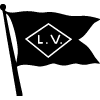
Lehigh Valley Railroad
The Lehigh Valley Railroad (reporting mark LV) was a railroad in the Northeastern United States built predominantly to haul anthracite coal from the Coal Region in Northeastern Pennsylvania to major consumer markets in Philadelphia, New York City, and elsewhere.
Overview
LV
1846–1976
Conrail (main line and branches lines were transferred to Norfolk Southern Railway and CSX; remaining Locomotives to Norfolk Southern)
4 ft 8+1⁄2 in (1,435 mm) standard gauge
On April 21, 1846, the railroad was authorized to provide freight transportation of passengers, goods, wares, merchandise, and minerals[1] in Pennsylvania. On September 20, 1847, the railroad was incorporated and established, initially called the Delaware, Lehigh, Schuylkill and Susquehanna Railroad Company.
On January 7, 1853, the railroad's name was changed to Lehigh Valley Railroad.[2] It was sometimes known as the Route of the Black Diamond; black diamond is a slang word for anthracite, the high-end type of Pennsylvania coal that it initially transported by boat down the Lehigh River.
The Lehigh Valley Railroad's original and primary route between Easton and Allentown was built in 1855. The line later expanded past Allentown to Lehigh Valley Terminal in Buffalo and past Easton to New York City, bringing the Lehigh Valley Railroad to these metropolitan areas. By December 31, 1925, the railroad controlled 1,363.7 miles of road and 3,533.3 miles of track. By 1970, this had dwindled to 927 miles of road and 1963 miles of track.
The first small repair shops for locomotives and cars were located in Delano, Wilkes-Barre, Weatherly, Hazleton, and South Easton. In 1902 these were mostly consolidated into the shops at Sayre, Pennsylvania on the New York State border, which featured a 750 by 336-foot machine shop with 48 erecting pits. Meanwhile, the shops at Packerton, Pennsylvania (north of Allentown) acted as the primary freight car shops.
Conrail maintained the line as a main line into the New York City area. The line became known as the Lehigh Line during Conrail ownership. Conrail abandoned most of the route in New York State to Buffalo after 1976, considerably shortening the line.
The majority of the Lehigh Line is now owned by the Norfolk Southern Railway (NS) and retains much of its original route in eastern Pennsylvania and New Jersey, although it no longer goes into New York City. The former Lehigh Valley tracks between Manville, New Jersey, and Newark are operated separately by Conrail Shared Assets Operations as their own Lehigh Line.
In 1976, the railroad ended operations and merged into Conrail along with several northeastern railroads that same year.
The LVRR operated several named trains in the post-World War II era. Among them:
The primary passenger motive power for the LVRR in the diesel era was the ALCO PA-1 car body diesel-electric locomotive, of which the LVRR had fourteen. These locomotives were also used in freight service during and after the era of LVRR passenger service. A pair of ALCO FA-2 FB-2 car body diesel-electric locomotives were also purchased to augment the PAs when necessary. These were FAs with steam generators, but they were not designated as FPA-2 units.
Due to declining passenger patronage, the Lehigh Valley successfully petitioned the Interstate Commerce Commission to terminate all passenger service. This took effect on February 4, 1961. The Maple Leaf and the John Wilkes were the last operating long-distance trains, terminated that day.[54] The only daylight New York-Buffalo train, the "Black Diamond", was discontinued in 1959. Budd Rail Diesel Car service would continue on a branch line (Lehighton-Hazleton) for an additional four days. The majority of passenger equipment is believed to have been scrapped some time after February 1961. Most serviceable equipment not retained for company service was sold to other roads.